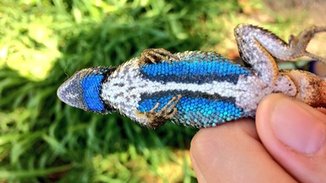
蜥蜴看见红色就会逃跑
No Bull: Lizards Flee When They See Red
蜥蜴看见红色就会逃跑
Western fence lizards are more spooked by red and gray shirts than they are by blue ones—perhaps because the males have blue bellies themselves. Christopher Intagliata reports.
相比蓝色的衬衣,西部篱笆蜥蜴更容易受到红色和灰色衬衣的惊吓,这也许是因为公蜥蜴的腹部本身就是蓝色的。
撰文\播音:克里斯托弗·因塔利亚塔(Christopher Intagliata)
You wouldn't think studying lizards is a particularly dangerous profession. Until, that is, sheriffs approach you with their guns drawn. "We get the cops called on us sometimes."
你应该从来不会觉得研究蜥蜴其实是一个非常危险的职业。除非警长举着枪找上你。“有时候警察真的会来找我们。”
Bree Putman, a behavioral ecologist at U.C.L.A. and the Natural History Museum of Los Angeles. Her colleague at the museum, Greg Pauly, really did end up on the wrong side of a gun once, and here's why:
来自加利福尼亚大学洛杉矶分校和洛杉矶自然历史博物馆的行为生态学家布雷·帕特曼(Bree Putman)如是说。她在博物馆的同事格雷·保利(Greg Pauly)曾经的确被人用枪误射,因为:
"A lot of times we're doing work at night in people's neighborhoods and we're using flashlights to look for geckos on the sides of people's houses. And so sometimes people will think we're criminals or burglars or something."
“我们经常晚上在居民区工作,靠打手电在别人房子的墙壁上寻找壁虎。所以有时候人们会以为我们是罪犯或者小偷什么的。”
The museum's solution was neon orange shirts with the museum logo. "And we call these shirts the ‘don't shoot me’ shirts." But the bright orange left Putman with a concern: that the color would spook the very animals they were trying to study.
博物馆提出的解决方法是让我们穿上带有博物馆标志的亮橘色衬衫。“而且我们把这些衬衫叫做‘别射我’衬衫。”但是这个亮黄色让普特曼有些担心:这个颜色可能会吓坏他们想要研究的动物。
So she devised an experiment. "I basically designed a study to show to the museum staff that these shirts were not going to be good for research, and that's what I found.”
所以,她设计了一个实验。“我主要是设计一个实验来向博物馆的员工解释这些衬衫会对研究不利,而这就是我的发现。”
In her trials, Putman wore tank tops of various colors—red, gray, light blue, dark blue—and then attempted to approach and capture western fence lizards in public and private parkland in L.A. And she found that when wearing dark blue, she could get twice as close to the lizards, compared to when she wore red. And she was about twice as likely to catch a lizard too, while wearing dark or light blue, compared to red or gray. The study appears in the journal PLOS ONE. [Breanna J. Putman et al., Fear no colors? Observer clothing color influences lizard escape behavior]
在她的实验中,普特曼穿着不同颜色的背心:红色、灰色、浅蓝色、深蓝色,然后在洛杉矶的公众和私人公园中尝试去接近、捕捉西部篱笆蜥蜴。她发现,当她穿着深蓝色的背心时,接近蜥蜴的距离是穿红色背心时的两倍。而且,穿浅蓝色或深蓝色背心时抓到蜥蜴的几率也是穿红色或灰色背心时的约两倍。这项研究发表在《公共科学图书馆·综合》(PLOS ONE)杂志上。
Putman thinks that the lizards may be more tolerant of blue hues, because they most closely resemble the blue patches males have on their bellies—a sexual signal. Other studies have shown that birds with orange and red plumage are similarly less creeped out by orange and red shirts. She's not ready to issue a dress code to hikers just yet, but:
普特曼觉得,蜥蜴可能对蓝色的容忍度更大。因为这和雄性蜥蜴腹部的蓝色斑点很像——那是它们的性信号。也有其他的研究表明,有着橘、红色羽毛的鸟类不会那么容易被橘、红色衬衫吓到。她还没有准备好向徒步旅行者发布穿着标准。但是,她觉得,
"You know for a scientist or biologist working with wild animals, you want to make sure either that you're wearing the same outfit every time you're going to do animal behavior. Or you want to randomize what you wear."
“你应该会明白,对于一个科学家或者说生物学家来说,在野外研究动物行为的时候,要么会希望每次都穿同样的衣服,要么就随便穿。”
As for those museum shirts, "I actually wear the orange shirt. I don't wear a blue shirt." Because studying wildlife in urban areas, you never know when you might encounter that other species: gun-toting Homo sapiens.
至于这些博物馆的衬衫,“实际上,我穿的是橘色的衬衫。而不是蓝色的。”因为在城里研究野生动物,你永远不会知道什么时候会碰上另一些物种——带枪的人类。
未经书面许可任何人不得复制或镜像
京ICP备11000850号-1
 京公网安备11010502039775号
京公网安备11010502039775号 信息网络传播视听节目许可证0111611号
国家科技基础条件平台

















